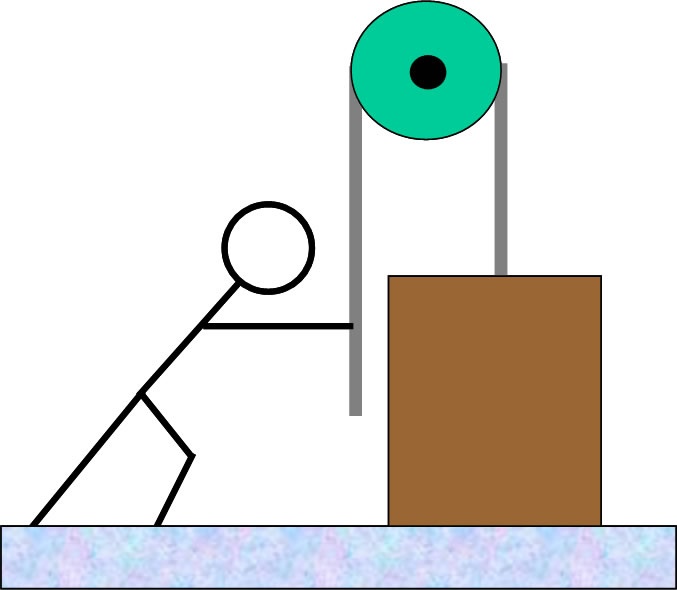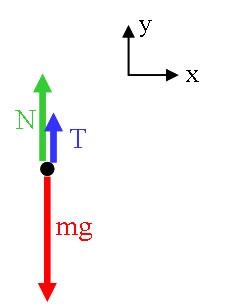Part A

A 10 kg box slides at a constant speed of 2 m/s along a smooth floor. What is the magnitude of the normal force exerted on the box by the floor?
Solution
System:
Interactions:
Model:
Approach:
Diagrammatic Representation
We begin with a free body diagram for the box:

Mathematical Representation
From the free body diagram, we can write the equations of Newton's 2nd Law. We ignore the x-direction, since there are no forces acting.
\begin
[ \sum F_
]\end
Because the box is sliding over level ground, it is not moving at all in the y direction. Thus, it certainly has no y-acceleration. Setting ay = 0 in the above equation gives:
\begin
[ N = mg = \mbox
]\end
Part B

A person pushes a 10 kg box along a smooth floor by applying a perfectly horizontal force of 20 N. The box accelerates horizontally at 2 m/s2. What is the magnitude of the normal force exerted on the box by the floor?
Solution
System:
Interactions:
Model:
Approach:
Diagrammatic Representation
We begin with a free body diagram for the box:

Mathematical Representation
From the free body diagram, we can write the equations of Newton's 2nd Law.
\begin
[ \sum F_
= F_
= ma_
]
[ \sum F_
]\end
Because the box is sliding over level ground, it is not moving at all in the y direction. Thus, it certainly has no y-acceleration. Setting ay = 0 in the y direction equation gives:
\begin
[ N = mg = \mbox
]\end
Part C

A person is trying to lift a 10 kg box by applying a perfectly vertical force of 20 N with the help of a pulley. What is the magnitude of the normal force exerted on the box by the floor?
Solution
System:
Interactions:
Model:
Approach:
Diagrammatic Representation
We begin with a free body diagram for the box:

Mathematical Representation
From the free body diagram, we can write the equations of Newton's 2nd Law. We ignore the x-direction, since there are no forces acting.
\begin
[ \sum F_
]\end
Because the box is sliding over level ground, it is not moving at all in the y direction. Thus, it certainly has no y-acceleration. Setting ay = 0 in the y direction equation gives:
\begin
Solving for the normal force gives:
\begin
[ N = mg - T = \mbox
]\end
When three or more forces act in a direction with zero acceleration, it is always a good idea to check your answer by putting the numbers on the free body diagram and making sure that they balance. In this case, T (20 N) and N (78 N) act to balance mg (98 N).
Follow up question: The floor no longer supports the entire weight of the box (98 N) because the rope is carrying some of the weight (20 N). How will the person's normal force be affected in this situation? If the floor is carrying so much less weight, what part of the building is now feeling an extra load?
Part D

A person pushes a 10 kg box along a smooth floor by applying force of 20 N. The force is applied at 30° below the horizontal. What is the magnitude of the normal force exerted on the box by the floor?
Solution
System:
Interactions:
Model:
Approach:
Diagrammatic Representation
We begin with a free body diagram for the box:

Mathematical Representation
From the free body diagram, we can write the equations of Newton's 2nd Law.
\begin
[\sum F_
= F_
\cos\theta = ma_
]
[ \sum F_
= N - mg - F_
\sin\theta = ma_
]\end
Because the box is sliding over level ground, it is not moving at all in the y direction. Thus, it certainly has no y-acceleration. Setting ay = 0 in the y direction equation gives:
\begin
[ N - mg -F_
\sin\theta = 0 ]\end
Solving for the normal force gives:
\begin
[ N = mg + F_
\sin\theta = \mbox
]\end
Again, we can check the force balance in the y direction. In this case mg (98 N) and FA,y (10 N) act to balance N (108 N).